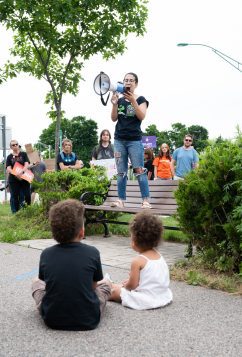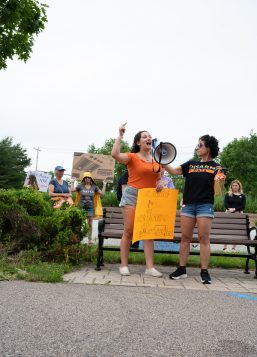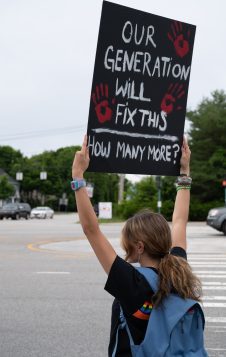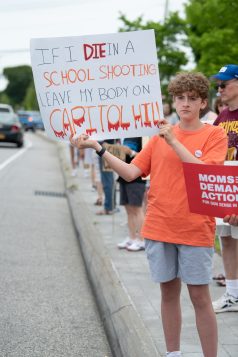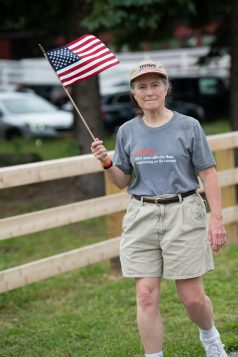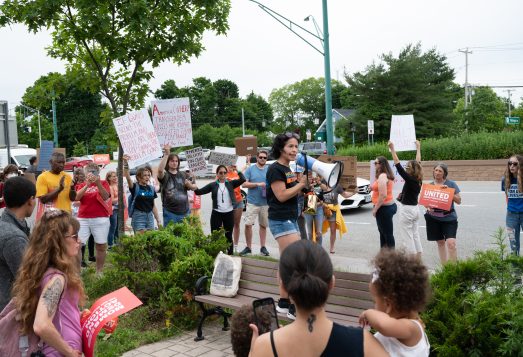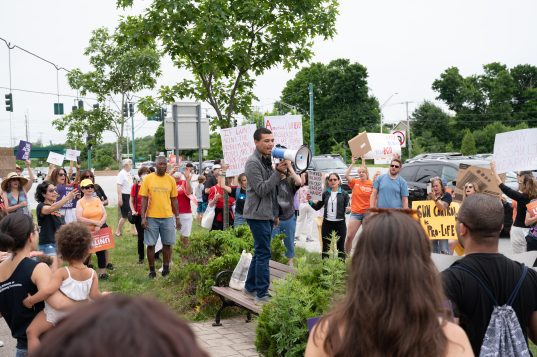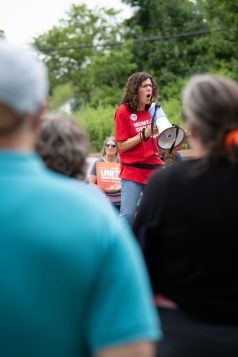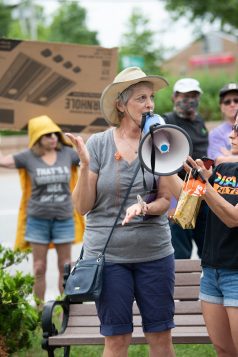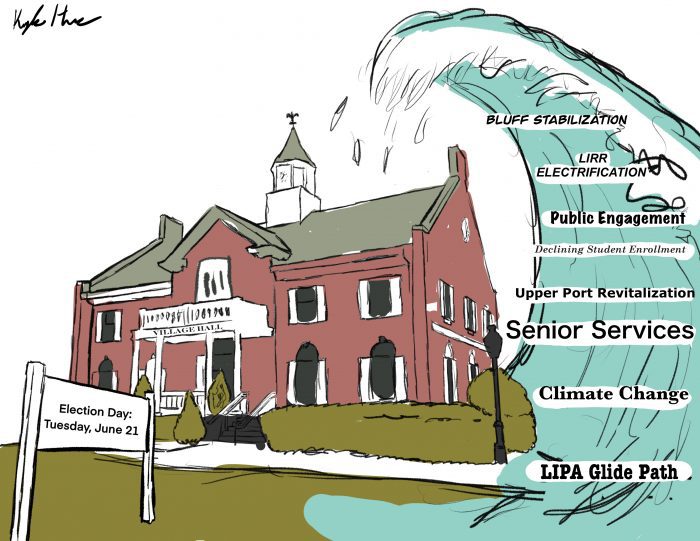As the June 21 election day nears, village trustee candidates had an opportunity to state their positions on a number of pressing issues. Candidates elaborated on their positions on issues ranging from the East Beach Bluff to the school district’s declining student enrollment to public engagement.
Would you vote to appropriate any funding to any upland project to protect the Port Jeff Country Club without a voter referendum?
Gerard Gang: It really depends upon what type of project is needed. I think if it involves the safety of the people and the village, the trustees were put in place by the people to make certain decisions, especially if it’s a safety issue. If it’s something of a large percentage and it’s within the code and regulations then, yes, it should be brought up for a referendum.
Ana Hozyainova: Absolutely not.
Rebecca Kassay: No, I would not vote to appropriate funding for an upland project at the country club without a voter referendum. At last Monday’s board meeting, I challenged my fellow board of trustee members and the mayor to consider passing a resolution at the coming June 20 board meeting to reduce the amount of the bond from $10 million to $5 million because that $5 million has already been spent on the lower wall. My challenge to them is to reduce the current bond amount and, in that, whichever step that the village would like to look at next — whether it’s an upper wall or upland improvements — the village board would need to involve the residents with a public hearing and my hope would be a public referendum for the work that comes next. The residents would need to be on board in order to approve the funds for the next project.
Bruce Miller: No.
Lauren Sheprow: That has already been done. There has been a vote to appropriate funding for the upland projects. They had a vote. I think that what the board of trustees did back at the end of 2021 when they unanimously agreed to fund the preservation of the East Beach bluff was exactly their responsibility. It was not an easy decision. I think it was a very difficult decision, but it was the decision that they were charged to make when they took their oath as trustee.
Aside from redistricting, how would you help boost student enrollment at Port Jefferson School District?
Gang: You could boost student enrollment in the school district outside of redistricting by bringing in new programs that may encourage other school districts to send their students to our schools for a special need, a special program, a special talent or craft or trade. Truly, the more programs we can create, the more parents will try to move into this village. I would love to bring back the sailing team. The elementary school through the high school had an incredible sailing team. If we can set ourselves apart from another school, they will come.
Kassay: It’s a very difficult challenge for districts nationwide and even worldwide in developed countries. For me, I would like to look into what has worked and what is working for districts that are also facing this challenge, and look for the proven solutions before guessing at what might actually help our school district.
Hozyainova: I am certainly open to exploring different ways in collaboration with the schools, which would require a number of studies to understand what is causing the decline in enrollment. We, as a government agency, are not able to mandate people to have children, and for us to attract more student populations requires an in-depth understanding of the factors that drive the decline in student enrollment. Only after we have understood those factors can we develop appropriate policies to encourage greater student populations.
Miller: I have 40 years of experience looking at this stuff. More condominiums mean more permanent residents and, therefore, a potential for more students. We’re having a lot of apartments instead. There are a lot of studios and one-bedrooms coming in — not typically the profile for families to stay and raise their kids long term.
Sheprow: This goes back to the affordability of living in Port Jefferson and trying to keep taxes down. The school district is out of the purview of the board of trustees, although there is a strong relationship there and a collegial relationship right now, which is good. There are a couple of steps that would have to be taken in order to help make living in Port Jefferson more affordable and attractive for young families. One of the things I have talked about is taking a look at the efficiency of operations. Are we being as efficient and as effective as we can operationally to keep our budgets under control? Are we being creative enough to help keep our finances in check and reduce our expenditures so that we aren’t reliant on taxpayer revenue to operate efficiently?
How can the village government be brought closer to the people?
Gang: Through communications. Communication is key. We’re talking about the possibility of changing the website once I’m in the office. Any way we can involve the residents and entice them to show up to meetings will also help the relationship between the village and the residents.
Hozyainova: The village government needs to go and speak to the people. Setting up various events that are dedicated specifically to the discussion of Port Jefferson’s issues — that are outside of business hours and that include younger children, older children, teenagers, and various levels of the population would be useful in making sure people have ample opportunities to engage the government.
Kassay: I think that having residents feel more confident that the village is seeking a dialogue — as opposed to the village moving forward on agendas that the public hasn’t been consulted about or given feedback about — is a really important first step. I think that the government — the board of trustees members and the mayor — are perhaps looking into ways to engage residents, similar to the new “residents night” that they will host usually once a year, where it’s a more informal way for residents to just discuss what’s going on in the village, any questions they may have, and feel that their voices are truly being heard.
Miller: One of my suggestions — and I’ve been insisting on this for quite a long time — is to have public meetings at Village Hall, but also to have them on Zoom where people can actually participate. I think the trustees on the board today are open. If you call them, it’s not like you will get put off. There’s another question of openness, which is a transparency issue, but that’s tangential. That was my position regarding the bluff, which is that you needed a public hearing on that.
Sheprow: If you have public forums at the Village Center or at the country club, you have ready-made facilities that you can benefit from. Even bringing in a representative to the board of education meetings once a month or so would be a good idea, whether it’s the mayor or a liaison from the board of trustees. I think that would be something that would also help to create more exposure and engagement from the community. Again, the community has to be interested and take that responsibility on, too.
If elected, you will be serving alongside one other candidate in this race. What is your message to your fellow candidates and do you have any concluding comments on this election?
Gang: My message to all the other candidates is to continue to be honest and to put your best foot forward for the good of this village. Everything in my campaign is based around increasing revenue and being there for the residents — a reach-out program, fuel assistance, health screenings, durable medical equipment that can be loaned, health insurance issues just to help our seniors have clarity, swimming programs, a calendar of events. I would love to see a program implemented that would help with tax abatement for our seniors, where they can work within the village for a minimum wage. Just imagine what this village could offer, if I became a trustee, to all of the age groups for additional amenities in this village.
Hozyainova: During my canvassing, the two biggest issues that came to the fore were government transparency and government accountability. My hope would be that whoever gets elected would engage with the people and their needs and that all of the policies put forward would reflect the wishes of the people of Port Jefferson to the greatest benefit of everyone involved. I believe that I have the skills to do so, but even if I am not elected I will continue pressing and advocating on behalf of my fellow neighbors and residents.
Kassay: I hope that if I am elected, whichever other candidate is elected will join me in asking questions, having deeper conversations about village actions, about the future of the village regarding large infrastructural planning, and generally engage in more dialogues between board members. I think that one of the most important takeaways from my first two years as a trustee is that we need a culture — both on and beyond the board of trustees — of conversation. That includes listening and sharing perspectives.
Miller: My message to whoever wins is that I hope we can cooperate, get together and just work for the betterment of Port Jefferson. There’s much to do in the village and we all need to try to get on the same page on many of the issues. We’re going to have differences on some of them, and that gets handled by a vote. We need to cooperate with one another. I think we’ve always been civil toward one another, and I hope we will continue with that as well.
Sheprow: I have a lot of respect for everyone who’s vying for this position. I learned a lot about them through the candidates forum. I feel like it would be a pleasure to serve with any one of them. I would just reiterate that it would be an honor and a pleasure to serve at the behest of the residents of our community. I would do all that I am able to do to make sure that my door is always open. I really look forward to serving my community and will be a responsible steward of the people of Port Jefferson, the infrastructure of Port Jefferson — and the whole environment of Port Jefferson.
Voting information
Voting will be held at the Village Center on Tuesday, June 21, from 6 a.m. to 9 p.m.

